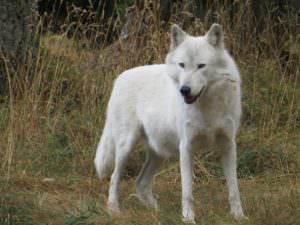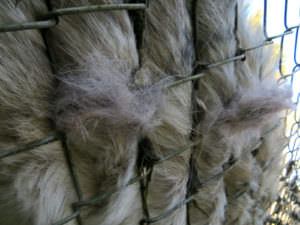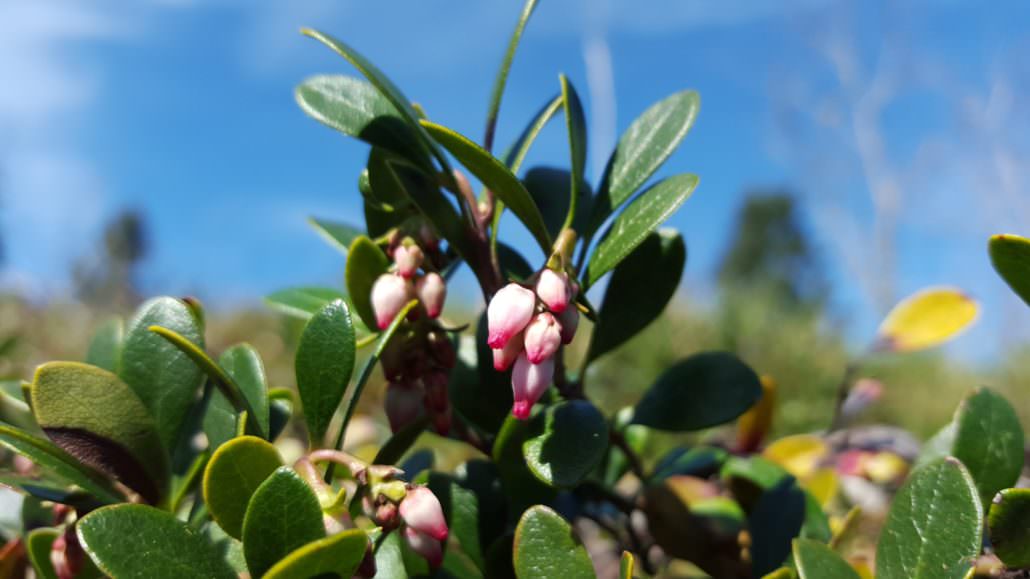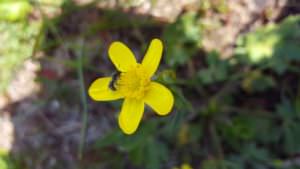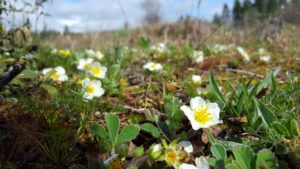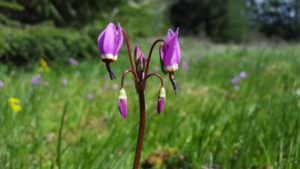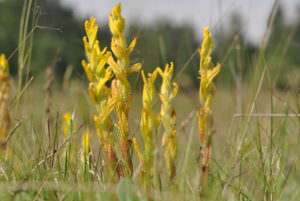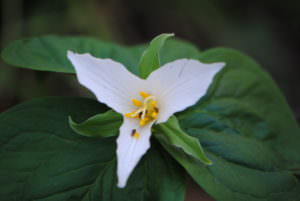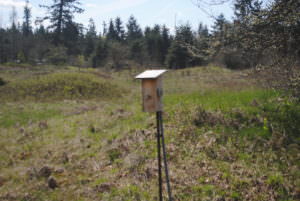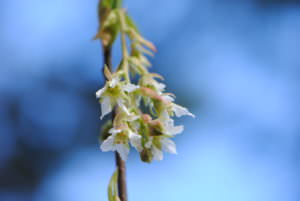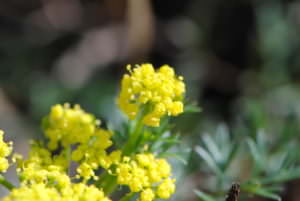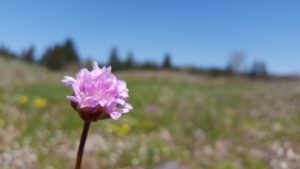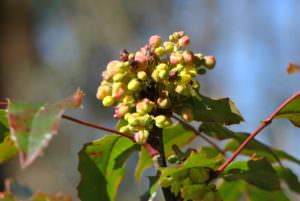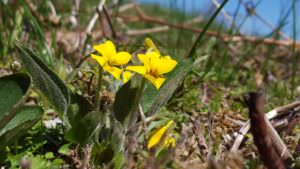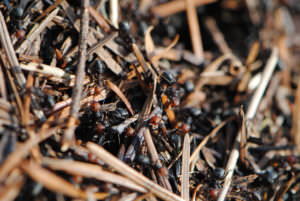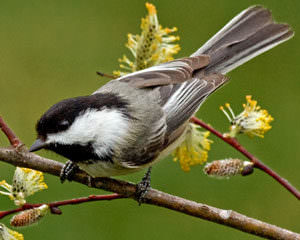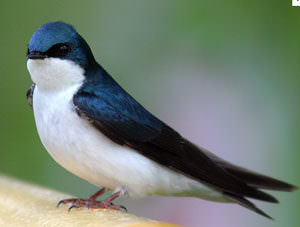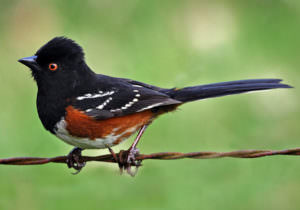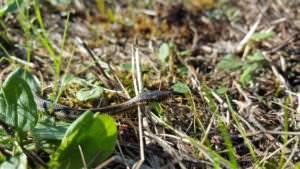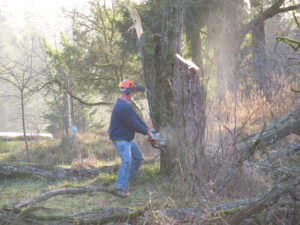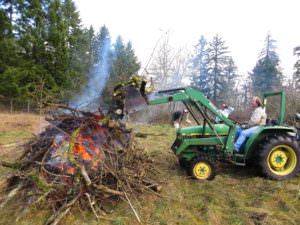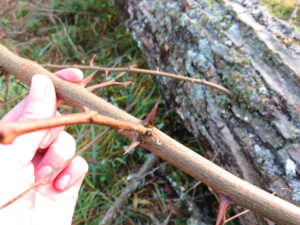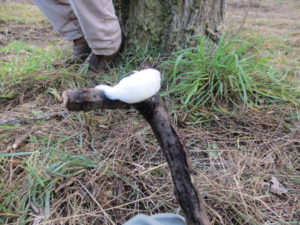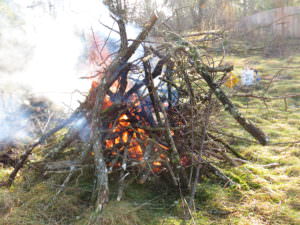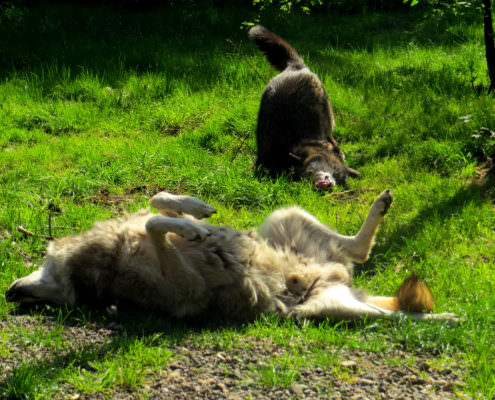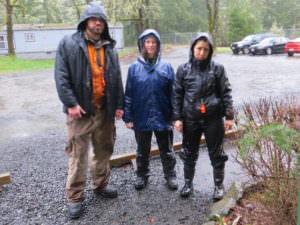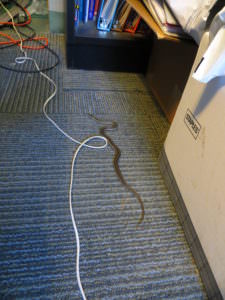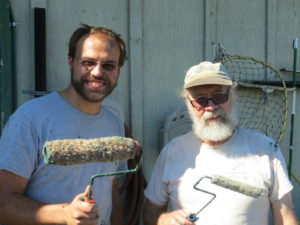Fur
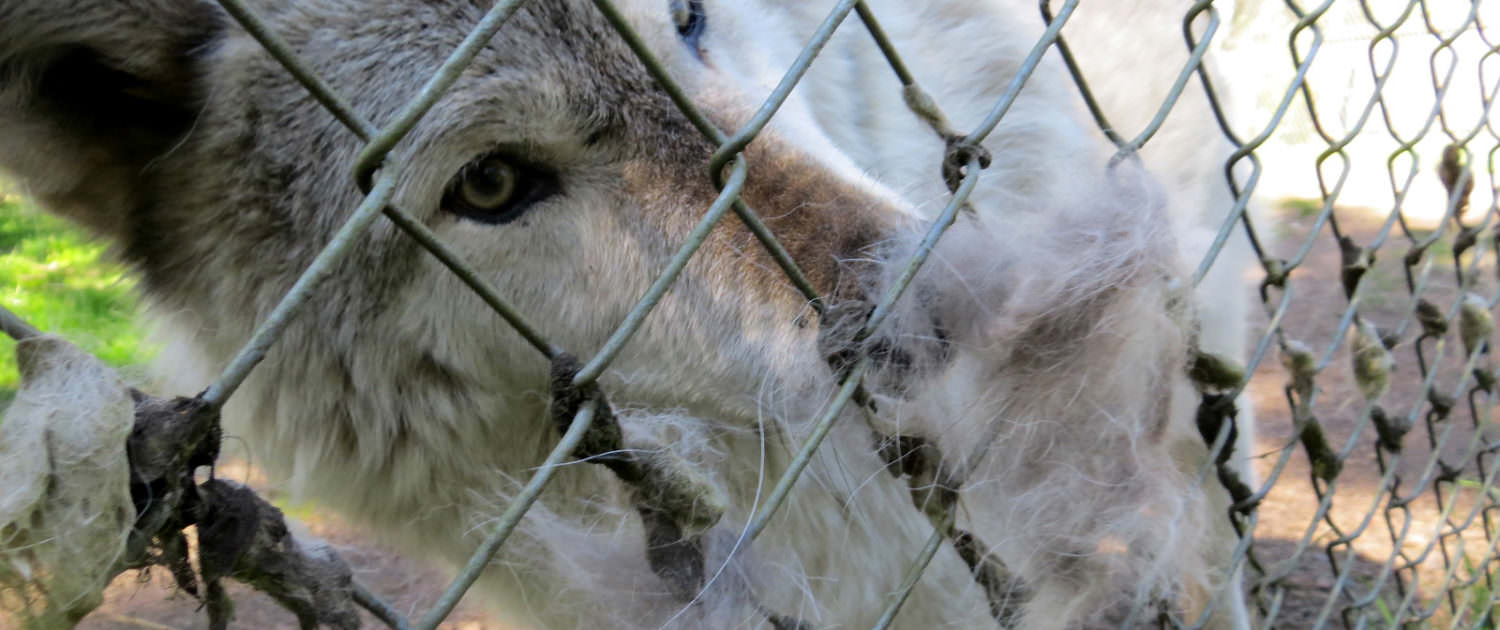
Klondike delights in the scent of generations of wolves who have left calling cards of fur on the fence
By Brennan Stoelb, Animal Care Specialist
Springtime is here. I know this not only because the trees are in bloom, but also because my house is covered with a thin layer of dog fur. As a matter of fact, after I typed that last sentence, I proceeded to pet my husky Winnie who was wet from the rain and my hand is now covered in a layer of fur.
If you have been to the sanctuary in the winter months you could be fooled into thinking that wolves weigh 150 pounds or more, based purely on their perceived girth. The reality is that wolves are so well insulated that their bulkiness in winter is just fur! A wolf’s coat is comprised of two different types of fur; a soft undercoat and coarser outer coat with longer guard hairs. The longest fur is on the back by the shoulders, often referred to as a “cape.”
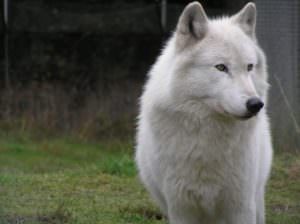
Bart with full winter coat
Wolves also have more fur in their ears than dogs to help protect the inner ear from the elements. When wolves are in extreme cold temperatures, say -30 degrees, their undercoat keeps them warm and you will often find them curled up in a ball with their noses tucked under their tails, like this husky.
So with their size in winter attributed to their fur, we can assume that the rest of the year they appear smaller.This true, but not for the reasons you may think. It makes sense to have more fur when it’s cold and less when it’s hot, but temperature isn’t the reason for the fur loss. Wolves, like all mammals, are photoperiodic- meaning that their endocrine cycles are regulated by the amount of daylight hours. In the spring as daylight hours increase, melatonin mediated changes cause prolactin levels to rise in both male and female wolves.
Prolactin is a hormone that triggers maternal and paternal behavior in wolves, among other species, such as denning, lactation, and shedding. The peak levels of prolactin coincide with the onset of summer and decrease throughout the rest of the year.Right now, the wolves are starting to look a little ragged, with clumps of fur hanging off of them.
You may even see a fence line or two that looks like it’s growing some fur. If you come and visit us this summer, just don’t be surprised if the wolves look smaller than the last time you were in the winter and be thankful that the hair isn’t on your furniture!
What’s blooming on the Wolf Haven prairie in early April
The nice weather of spring has brought beautiful wildflowers to the South Sound prairies. If you come by Wolf Haven International in the next couple weeks you will be in for quite a show on the prairie.
As you walk along the trail, you might first notice the shining yellow Western Buttercups (Ranunculus occidentalis) or the low white flowers of the Virginia Strawberry (Fragaria virginiana). Make sure you take a closer look
between the green Camas shoots coming up, because the striking Henderson’s Shooting Star (Dodecatheon hendersonii) is in full bloom for a while longer. This flower is sort of built inside out, with the pink-purple petals sticking backwards towards the stem, leaving the stamens and pistil to be pointed straight out of the flower.
Some mounds are covered in a dark green plant called kinnikinnick (Arctostaphylos uva-ursi) which is just starting to get its light pink bunches of bell-shaped flowers. Make sure not to step off of the trail, as kinnikinnick is a host plant for the caterpillars of the rare Hoary Elfin butterfly.
When you get closer to the Grandfather Tree, you will be between two areas that have had prescribed fire applied to them in the past few years, one of which was burned in 2013. These areas will have some new and easier to see flowers. The Early Blue Violet (Viola adunca) is sprouting up in deep purple patches near the trail.
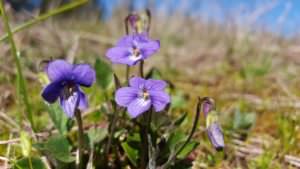
Early Blue Violet
Careful not to leave the trail, you can look on the North side of the trail, before the Grandfather Tree, to try and spot some Golden Paintbrush (Castilleja levisecta) coming up. Golden Paintbrush is federally listed as threatened, and state listed as endangered, so if you see it, do not disturb it. All paintbrush species are hemiparasites, which means that they have some chlorophyll with which to make some food, but they get most of their nutrients by stealing it from nearby plant’s roots. The brilliant colors associated with
paintbrush plants are not their flowers, but rather colorful leaves. Golden Paintbrush has inconspicuous green flowers between the bright yellow leaves.
Other flowers in this area are the very small blue flowers of Blue Eyed Mary (Collinsia parviflora) and the tall stalks with freshly blooming white flowers of Wholeleaf Saxifrage (Micanthes integrifolia). Off in the forest at the edge of the prairie, there is still a Pacific Trillium (Trillium ovatum) or two in bloom. The famous Common Camas (Camassia quamash) buds have been shooting up, and will start blooming within the next few days, but expect them to cover the prairie in large purple flowers in May.
Many of the plants from last month’s blog are still blooming, and all of the same animals are out, to be joined by many more butterflies and other insect pollinators. Most of the Bluebird boxes are still empty, but it seems that a pair of Tree Swallows is going to nest in the bird box that has a Washington Fish and Wildlife live webcam in it. Most days I see a bird or two in it, and there are more sticks appearing in it every day. You can watch the live bird box cam here: http://wdfw.wa.gov/wildwatch/bluebirdcam/video.html
Anne Schuster,
Center for Natural Lands Management AmeriCorps,
Wolf Haven Outreach and Restoration Technician
Speak Up for Wolves in Alaska
“If we leave wolves alone, we’ll be the ones to benefit.” Marybeth Holleman
This guest Call to Action is by Marybeth Holleman, co-author of the book Among Wolves – Gordon Haber’s Insights into Alaska’s Most Misunderstood Animal. Ms. Holleman has also written a wonderful opinion page – Just Like Us, Wolves Need Family to Thrive- which painstakingly recounts the fatal flaws in the US Fish and Wildlife proposal to delist the gray wolf.
“Wolves go to great lengths to stay with family; when important members are lost, families can disintegrate and remaining individuals often die.”
Among Wolves: What You Can Do by MaryBeth Holleman
Ask State of Alaska and U.S. Department of Interior to work together to create a permanent protective buffer for Denali’s wolves on state lands along the northeastern borders of Denali National Park. Ask for this “win-win” solution: that the State of Alaska transfer a permanent no-take wildlife buffer conservation easement east of the national park to the federal government, in exchange for the federal government transferring a like-valued easement, or federal surplus property, or purchase value, to the State of Alaska. A no-take buffer northeast of the park is the only way to rebuild and then sustain Denali’s wolf populations.
Write to:
Governor Sean Parnell: governor@alaska.gov
Don Striker, Denali National Park Superintendent Don Striker: don_striker@nps.gov
Interior Secretary Sally Jewell: secretary@ios.doi.gov
copy:
Jon Jarvis, National Park Service Director in DC: jon_jarvis@nps.gov
Joel Hard, NPS Alaska Deputy Regional Director: joel_hard@nps.gov
Cora Campbell, Commissioner, Alaska Dept. of Fish and Game: cora.campbell@alaska.gov
Joe Balash, Commissioner, Alaska Dept of Natural Resources: joe.balash@alaska.gov
“Whenever an alpha wolf was shot or trapped, it set off a cascade of events that left most of the family dead and the rest scattered, rag-tag orphans.”
Ask Secretary of Interior Sally Jewell to condition the annual transfer of federal funds to state wildlife agencies – through the Pittman-Robertson Federal Aid in Wildlife Restoration Act – upon the state cooperatively managing wildlife around federally protected areas, such as national parks and wildlife refuges. Alaska received $49 million from the Dept. of Interior just this year, most of it going to the ADFG Game Division, which conducts “intensive management” (predator control) that subverts national goals of wildlife conservation and restoration.
Write to:
Interior Secretary Sally Jewell: secretary@ios.doi.gov, feedback@ios.doi.gov
copy:
Jon Jarvis, National Park Service Director in DC: jon_jarvis@nps.gov
Joel Hard, NPS Alaska Deputy Regional Director: joel_hard@nps.gov
What to See on the Prairie Now
If you get a chance to come to Wolf Haven International, you will be lucky enough to have a chance to see beautiful native plants and wildlife on Wolf Haven’s unique mounded prairie. For the next few months, I will be letting people know what they can expect to see on the prairie.
Early March brought the warm, wet weather that the plants love, and there was an explosion of growth! Along the edges of the prairie, the early blooming Indian plum (Oemleria cerasiformis) started off strong, along with the first green shoots of the camas plants, which will paint the prairie purple in May.
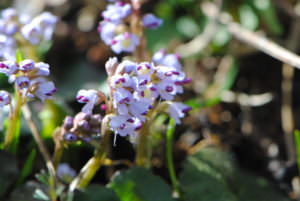
Snow Queen
Along Wolf Haven’s prairie path you will be able to see the small, light purple snow queen (Synthyris reniformis) and the yellow biscuitroot (Lomatium sp.) popping up
everywhere. The Biscuitroot makes pocket gophers extra happy, since they love to pull the plants underground by their roots and eat the whole thing. Nearer to the Grandfather Tree, you might see the pink flowers of sea thrift (Armeria maritima) on long green stalks. The sea thrift and some of the biscuitroot was planted by the Center for Natural Lands Management in November, and had to be protected all winter from being pulled out by Wolf Haven’s resident ravens, and they managed to survive the winter!
In Wolf Haven’s forested areas, the tall oregon grape (Mahonia aquifolium) and yellow wood violet (Viola biflora) are beginning to get their flowers. Keep an eye on your feet as you walk under the Grandfather Tree, since the thatch mound ants (Formica obscuripes) are waking up for the warm season and their attack is painful if you step into one of their gigantic anthills.
I would also bring a pair of binoculars if you have them, since the birds are out and singing up a storm. Chestnut and Black-capped Chickadees are hopping around the trees, along with Dark-eyed Juncos, and Golden-crowned Kinglets. Spotted Towhees and American Robins are calling, from shrubs.
Turn your binoculars to one of the many snags on the prairie if you hear the drumming, there might be a Downy Woodpecker or a Northern Flicker hammering away in search of insects. Bald eagles and Red-tailed Hawks often sit on top of the Grandfather Tree and the snags around the Prairie. If you hear a chattering above you, look up to see the aerial aerobatics of Tree Swallows as they zoom around, eating flying insects.
There are many wooden boxes on poles spread around the prairie, these are nest boxes for Western Bluebirds, but often Tree Swallows make nests in them instead. If you want to keep an eye on the bluebird boxes from your home, one of Wolf Haven’s has a Washington Fish and Wildlife live web cam in it, which you can watch here: http://wdfw.wa.gov/wildwatch/bluebirdcam/video.html , so far I have only seen tree swallows checking it out. Of course, there is always Wolf Haven’s Corvid population, with many Common Ravens, American Crows, and Steller’s Jays making noise and imitating Red Tailed Hawk calls.
As far as non-birds go, March is chorus frog breeding season, and their ribbits can be heard from Wolf Haven’s adjoining wetland. If it is a sunny day, there might be a garter snake or two in the grass or on the path, warming themselves in the light. After dark, Wolf Haven might be closed, but the bat boxes near the parking lot are always open for bats, which have been leaving guano (poo) below them, to let us know the bats are here!
Wolf Haven International is on their Spring/Summer schedule from April 2 – September 30, which means we’re open to the public six days a week (always closed on Tuesday). Be sure to visit the prairie when you come to Wolf Haven so you can see all the cool things I’m seeing!
Anne Schuster,
Center for Natural Lands Management AmeriCorps,
Wolf Haven Outreach and Restoration Technician
Conservation Groups Collaborate to Celebrate Mexican Wolf
During the last week of March, wildlife advocates, wolf education centers, and captive breeding facilities celebrate the 16th anniversary of the return of the endangered Mexican wolf to its ancestral home in the wilds of the southwest. Missing from the landscape for more than 30 years, the rarest and most unique subspecies of the gray wolf was reintroduced to the wild on March 29, 1998. Hashtag LoboWeek is being used on all social media platforms as we jointly post information about this beautiful and still endangered animal.
 |
| Moss (M1066), a male Mexican wolf at Wolf Haven International |
Thirty-eight years after receiving protection under the Endangered Species Act, the Mexican wolf remains the most endangered mammal in North America and the most endangered subspecies of gray wolf in the world. It is estimated that a minimum of 83 Mexican wolves live in the wild and 248 in captivity in 52 facilities.
Protecting native prairies by removing invasive trees
People who have visited Wolf Haven before might have noticed some large trees in a small grassy area, just west of the parking lot, near three bat boxes. Those trees were Black Locust Trees, also known as False Acacia, or by its scientific name Robinia pseudoacacia. Black Locust trees are native to the Southeastern United States, but have been transplanted by people to other parts of the world, and have become invasive in many areas, including the Pacific Northwest. The Black Locust trees on Wolf Haven’s property were likely planted by the family of a homesteader who owned the area previously. As part of our mission to restore and protect native prairies, the Center For Natural Lands Management (CNLM) had a volunteer day at Wolf Haven to get rid of the invasive Black Locust Trees.
We started in the morning by cutting the trees down with chainsaws, then we cut the trees up into manageable sizes. Meanwhile, a fire was being started with kindling and smaller branches. As the fire grew, we were able to put larger and larger pieces of black locust onto the burn piles, or bonfires as they can be called. Some of the logs were so large that we needed Wolf Haven’s Grounds/Facilities Manager, Tim McElwee, to help us on the tractor.
Like true Acacias, False Acacias have thorns, which we had to be careful with
when cutting and holding the branches. These thorns are up to 2 centimeters long, and grow in pairs along most of the smaller branches. In addition to these thorns, Black Locusts have a toxin that can make livestock who eat parts of the plant sick, as well acting as a fish toxin. Through the day, we noticed a foul-smelling white foam boiling out of the ends of branches and logs. This foam was probably the toxin oozing out of the plant and becoming inactive by the heat.
By the end of the day, we had two huge burn piles, which were too hot to get within a few feet of, burning white hot. CNLM and Wolf Haven hope that with the removal of these invasive trees, the small oaks and apple trees in the same area will get more sun, the bat boxes will get more use (since bats prefer to use boxes in open areas), and the area will be turned into a demo-prairie to grab visitor’s attention as they enter Wolf Haven.
Anne Schuster
Center for Natural Lands Management AmeriCorps, Wolf Haven Outreach and Restoration Technician
What It’s Like to Work With Wolves (part 5 of a 5-part series)
So Why Work with Wolves? by Brennan Stoelb, Animal Care Specialist
When it comes to getting messy, it’s part of the job. I obviously shop at Goodwill. I know that the animals are getting a great variety of food and that care and thought is used to ensure that they remain healthy. It’s also great to know that the road kill is being used for a great cause.
So at this point, we’ve learned that 1) animal care doesn’t play with wolves 2) it can be pretty unpleasant to work in inclement weather and 3) animal care staff not only deal with wolves, but can also be terrorized by the local wildlife (snakes and hornets, for example) and 4) it can be a pretty stinky job. That hits the nail on the head, doesn’t it?
So why do I it? Well, when an animal wants nothing to do with me, doesn’t seek my attention, as in the case of wolves, they are simply doing what they should be doing. It means they are acting as a wild animal. We all want to be wanted and needed, but all they need is to be is left alone. Our residents always arrive at Wolf Haven with varying degrees of human sociability, due to their unique circumstances, and that’s ok. As long as they are comfortable with my presence as I go about my day, performing tasks to allow them a good life, I’m content with that.
As for the weather, very rarely do I look at the forecast. I simply assume that every day the weather will be awful and then I’m never let down. I get to be outside, and I’ll never argue with that.
As for the local wildlife……there is nothing redeeming about snakes and hornets.
THE END

